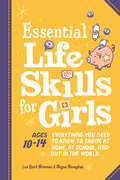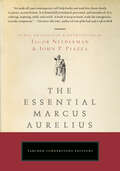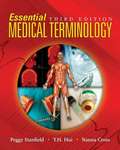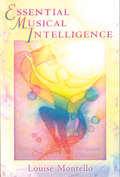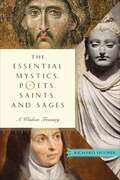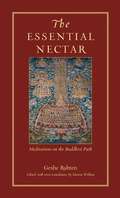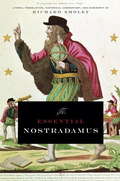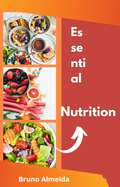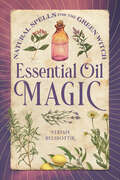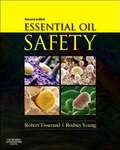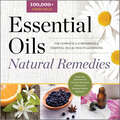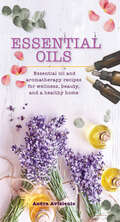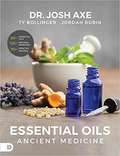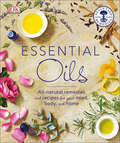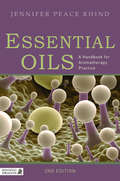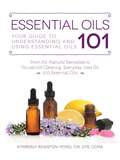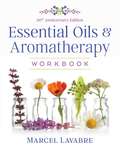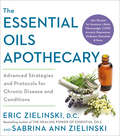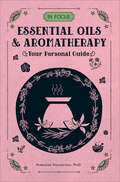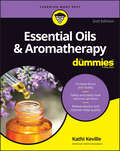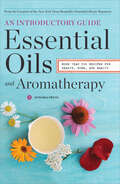- Table View
- List View
Essential Life Skills for Girls: Everything You Need to Know to Thrive at Home, at School, and Out in the World
by Lisa Quirk Weinman Megan MonaghanConfidently tackle tasks and everyday life with this guide to life skills for girls.Does the preteen girl in your life know how to wash her clothes? Plunge a toilet? Leave a tip? Read a map? Manage a bank account? Do you have the time and energy to teach her? Let Essential Life Skills for Girls lead the way with the tools she needs to succeed. These critical life skills will help her become a responsible, resilient, and confident young woman at home, at school, and out in the modern world. Designed for girls ages 10–14 who need to learn the ins and outs of personal hygiene, clothing care, communication, school success, and much moreAddresses kids living in a digital age; the skills include social media safety, texting with care, online communication, and other ways girls live their tech-savvy livesEasy to read, absorb, and remember, particularly for preteens with short attention spansHelps girls gain confidence and become independent (and helpful to family and friends)Detailed checklists let girls mark off skills they&’ve learned and challenge themselves to learn them all!
The Essential Marcus Aurelius
by Jacob Needleman John P. PiazzaThis inaugural-and all new-Tarcher Cornerstone Edition presents a stunningly relevant and reliable translation of the thoughts and aphorisms of the Stoic philosopher and Roman emperor Marcus Aurelius, properly placing the philosopher-king's writings within the vein of the world's great religious and ethical traditions. The late antique world possessed no voice like that of Roman emperor Marcus Aurelius (121-180 CE). His private meditations on what constitutes a good life have withstood the centuries and reach us today with the same penetrating clarity and shining light as the words of Shakespeare, Emerson, or Thoreau. In this remarkable new translation, bestselling religious philosopher Jacob Needleman and classics scholar John P. Piazza have retained the depth of Marcus's perspective on life. They have carefully selected and faithfully rendered those passages that clarify Marcus's role as someone who stood within the great religious and ethical traditions that extend throughout every culture in human history. The voice that emerges from their translation is a universal one, equally recognizable to students of Christ, Buddha, the Vedas, the Talmud, and to anyone who sincerely searches for a way of meaning in contemporary life. .
Essential Medical Terminology (3rd edition)
by Peggy Stanfield Nanna CrossThis best-selling introduction to medical terminology text is flexible enough to be used in a traditional or a self-instructional course format. Suited for students of all levels in the allied health professions, this text provides the appropriate amount of detail needed to learn the basics of medical terminology. After studying the fundamentals of pronunciation, students can study the chapters in any order the instructor deems appropriate The Third Edition also includes a new chapter on Cancer Medicine and a user-friendly CD-ROM with interactive flashcards, crossword puzzles, and additional exercises. This text with helpful online resources is highly accessible for all health care students, offering a wealth of valuable information at an attractive price. Read the Preface And The Guidelines on How to Use This Book! Do you want to provide your Medical Terminology students with an easy-to-use online learning experience? Our new JBCourseManager is a free online resource when you adopt! JBCourseManager for Essential Medical Terminology, Third Edition features: Pre-loaded instructor resources as well as the function to upload your own Medical search term function Medical term of the day Ability to add your own assignments, quizzes, wikis, workshops, blogs, etc. , and change or remove the pre-loaded content Links to medical term pronounciation Accessible calendar with "upcoming events" reminders Threaded discussion forums, live chat sessions, and instant messaging capabilities Unique discussion forum setting, known as our "Q&A", cuts down on students copying answers Comprehensive reports to view all student activity Complete Companion Website with a vast array of resources including audio files
Essential Musical Intelligence
by Louise MontelloMusic fills our lives. From TV commercials to the car radio, we rarely live one single day without hearing a song. But what if you could consciously use music to foster self-awareness, creativity, and, ultimately, deep healing of the body, mind, and spirit? Through her clinical practice and research, Dr. Louise Montello has discovered what she calls Essential Musical Intelligence - our innate ability to use music and sound to bypass the defenses of the conscious mind and move directly into the emotional/soul centers where true healing can occur. This groundbreaking book draws from the wisdom of Eastern philosophies and guides us through a systematic musical journey where we learn a series of clinically proven EMI exercises to balance and harmonize all five levels of consciousness - the body, breath/energy, mind, imagination/intellect, and the realm of bliss - leading to deep and lasting change. Essential Musical Intelligence is a powerful new system of self-healing which is deeply intuitive, creative, spiritually arousing, and fun.
Essential Musical Intelligence
by Louise MontelloMusic fills our lives. From TV commercials to the car radio, we rarely live one single day without hearing a song. But what if you could consciously use music to foster self-awareness, creativity, and, ultimately, deep healing of the body, mind, and spirit?Through her clinical practice and research, Dr. Louise Montello has discovered what she calls Essential Musical Intelligence - our innate ability to use music and sound to bypass the defenses of the conscious mind and move directly into the emotional/soul centers where true healing can occur. This groundbreaking book draws from the wisdom of Eastern philosophies and guides us through a systematic musical journey where we learn a series of clinically proven EMI exercises to balance and harmonize all five levels of consciousness - the body, breath/energy, mind, imagination/intellect, and the realm of bliss - leading to deep and lasting change. The book is full of case histories and personal anecdotes that speak of the wondrous results of integrating EMI into people's lives.Essential Musical Intelligence is a powerful new system of self-healing which is deeply intuitive, creative, spiritually arousing, and fun - encouraging us to find and sing the song of the soul daily as we enjoy ever increasing states of health, creativity and well-being.
The Essential Mystics, Poets, Saints, and Sages: A Wisdom Treasury
by Richard Hooper&“A first-rate collection of multifaith prose and poetry by sages and seers on the mystical path . . . [an] extraordinary resource.&” —Spirituality and PracticeThe Essential Mystics, Poets, Saints, and Sages is a treasury of quotes and passages from the great Sufi mystics, Buddhists, Hindus, Taoists, Jews, and Christians throughout the centuries. This collection, curated by religious scholar Richard Hooper, stresses the beauty of religious language and mystical experience, including hundreds of entries from world&’s major religious traditions, the greatest poets, mystics, sages, and saints of all time. Included are selections from William Blake, Ramakrishna, Rumi, St. John of the Cross, Osho, Tagore, Chuang Tzu, and many more. The selections are given context by the introductory essays by Hooper, which explore the Perennial Philosophy, the nature of the mystical experience, and the way of non-dualism.The Essential Mystics, Poets, Saints, and Sages is an ideal gift as well as a source for daily guidance and support, regardless of the religious or sectarian affiliations.
The Essential Nectar
by Geshe Rabten Martin WillsonExploring crucial points on the path to enlightenment, "Stages of the Path" literature continues to hold its place as one of the great treasures of Buddhist thought. In this volume, Geshe Rabten presents a structured explanation of the popular and practical text, The Essential Nectar of Holy Doctrine, by the 18th century scholar Yeshe Tsöndru . Geshe Rabten's teachings reveal how we may see life's great value and, by taking up the profound practice described herein, make the most of its abundant opportunity. In a voice both sweet and potent, The Essential Nectar reveals the essence of the path to enlightenment.
The Essential Nostradamus
by Richard SmoleyA handsome, compact new edition of the singularly reliable translation of the writings of history's most famous seer-now published with a new afterword on Nostradamus and 2012. The prophecies of Nostradamus have ignited intense fascination throughout the West since they were first published in the sixteenth century. These enigmatic quatrains have gained special meaning for many during our current countdown to the year 2012. The relationship between Nostradamus's prophecies and the Mayan prophecy of 2012 is hotly debated over the Internet and is the focus of today's most popular television documentaries. Now The Essential Nostradamus-the definitive literal translation of his key verses-is redesigned, reset, and repackaged in an affordable and beautifully produced Tarcher Cornerstone Edition. This volume features a brand-new afterword from translator/commentator Richard Smoley, critiquing the Nostradamus legacy in light of the Mayan prophecies about 2012. Smoley is one of today's most respected writers on esotericism, and his new afterword fully (and realistically) assesses the question of Nostradamus's prophecies in relation to 2012, engaging readers who are hungry to learn more and want help sorting fact from fiction. Perfect for any who are curious, and for scholars and students who want to understand the real content of these haunting verses, The Essential Nostradamus is the key sourcebook of its kind. .
The Essential Nostradamus
by Richard SmoleyFrom his predictions about life and death in the Middle French court of Catherine de' Medici to his uncannily suggestive preconceptions of World War II, Michel de Nostradamus has aroused continual fascination-and commercialization-in the West. Today, many search his elliptical "centuries"-or collected verses-for new truths about 9/11 and End Times, while supermarket tabloids routinely falsify and exploit his pronouncements. What is the difference between prophecy and prediction, and how has it led to a misuse of the ideas of Nostradamus, as well as those of other post-biblical prognosticators? What is the nature of the oracular tradition in the West-stretching back to the oracle at Delphi-and how can Nostradamus be understood from this perspective? In The Essential Nostradamus, the highly regarded spiritual thinker and writer Richard Smoley provides a true sourcebook in the life and messages of one of history's most peculiar figures. This volume offers a host of advantages beyond other collections of Nostradamus's work. Many commentators on Nostradamus take liberties in their translations, further confusing the matter of what the prophetic quatrains actually said. In The Essential Nostradamus, Smoley presents a fresh, scholarly, and literal translation of Nostradamus's Middle French, allowing readers to make their own determination as to the passages' historical references and accuracy. Smoley also supplies detailed commentary on Nostradamus's key quatrains, with a sharp eye toward the political and social events of the writer's era-elements that many commentators overlook or fail to grasp. An authoritative biographical essay-highlighting Nostradamus's separate roles as physician, astrologer, and prognosticator-rounds out the volume to create a truly essential exposition of the work of one of Western culture's most mysterious men.
Essential Nutrition (Health Series #1)
by Bruno AlmeidaThe writer has tried to be as accurate and complete as possible in the creation of this report, but he does not guarantee the content described due to the rapid changes on the internet. Although every attempt has been made to verify all information in this publication, the publisher assumes no responsibility for errors, omissions, or misinterpretations of this book. Any references to specific people, organizations are not intentional. In practical advice books, as in life, there are no guarantees for an outcome. Readers are warned to make their own judgment about their circumstances and act accordingly. This book is not intended to be used as legal counsel. All readers are advised to seek the services of competent professionals in the legal fields.
Essential Oil Magic: Natural Spells for the Green Witch
by Vervain HelsdottirCultivate your craft with the natural power of essential oil magic Distilled from the most fragrant, magical, and healing plants, essential oils have been used in witchcraft for thousands of years. Essential Oil Magic is your own personal reference guide to making magic with oils. It simplifies and modernizes the practice, showing any witch how to use potent plant essences to transform their body, mind, and spirit. Discover detailed profiles on 30 powerful essential oils like basil, cedar, and sage, then explore an array of rituals and recipes that will elevate your practice and the magic you can conjure. Try out homemade spells like: Clear The Air of stagnant energy with a diffusion of lavender and black spruce for your home. Attract love and romance with a Goddess Body Wash of honey, patchouli, and rose. Manifest wealth with a Pocket Pyrite charm anointed with orange and ginger. Practice the art of oil magic and unlock the green witch within.
Essential Oil Pocket Reference, third edition
by Essential Science PublishingReference on Essential oils and their use and profiles.
Essential Oil Safety: A Guide For Health Care Professionals (Second Edition)
by Robert Tisserand Tony Balacs Rodney YoungThe second edition of this book is virtually a new book. It is the only comprehensive text on the safety of essential oils, the first review of essential oil/drug interactions, and it provides detailed essential oil constituent data not found in any other text. Much of the existing text has been re-written, and 80% of the text is completely new. There are 400 comprehensive essential oil profiles and almost 4000 references. There are new chapters on the respiratory system, the cardiovascular system, the urinary system, the digestive system and the nervous system. For each essential oil there is a full breakdown of constituents, and a clear categorization of hazards and risks, with recommended maximum doses and concentrations. There are also 206 Constituent Profiles. There is considerable discussion of carcinogens, the human relevance of some of the animal data, the validity of treating an essential oil as if it was a single chemical, and the arbitrary nature of uncertainty factors. There is a critique of current regulations. The only comprehensive text on the safety of essential oils The first review of essential oil/drug interactions Detailed essential oil constituent data not found in any other text Essential oil safety guidelines 400 essential oil profiles Five new chapters 305 new essential oil profiles, including Cedarwood, Clary sage, Lavender, Rose, Sandalwood, Tea tree 79 new constituent profiles Five new chapters: the respiratory system, the cardiovascular system, the urinary system, the digestive system, the nervous system. Significantly expanded text
Essential Oils: The Complete A-Z Reference of Essential Oils for Health and Healing
by Althea PressThe essential guide to lifelong healing with essential oils.The healing potential of essential oils may be limitless, but it's difficult to know how and where to begin when you don't have a prescription. With over 100 recipes for natural alternatives to traditional medicine, Essential Oils Natural Remedies provides a comprehensive reference to herbal healing without the hassle, expense, and frustration that comes with consulting doctors and taking prescription medication. In these pages, practitioners of all levels will learn a lifetime of herbal remedies from how to treat the urge to itch chicken pox with lavender-tea tree salve to soothing away arthritis symptoms with peppermint oil. Designed for use with any brand of essential oils, this organized and insightful guide is the only helping hand you'll need for natural healing.Essential Oils Natural Remedies includes:300 Home Remedies to heal and mitigate symptoms for over 170 different ailmentsProfiles of 75 Essential Oils plus information on medicinal uses, application methods, blending, and precautionsRecipes for Any Brand allow you to make all of the recipes in this book with your preferred brand of essential oilsFeaturing treatments for: Allergies, Bloating, Congestion, Dry Skin, Flu, Hives, Infection, Leg Cramps, Motion Sickness, Tension Headache, Toothache, Varicose Veins, and much more!Practice herbal healing from home with Essential Oils Natural Remedies.
Essential Oils: Essential Oil and Aromatherapy Recipes for Wellness, Beauty, and a Healthy Home (Essentials)
by Audra AvizienisDiscover the healing power of 115 essential oils in this modern aromatherapy guide with practical tips for wellness, beauty, and a healthy home.Essential Oils takes you on an aromatic journey that explores the exquisite fragrances and healing powers of essential oils. Discover the many benefits of the ancient practice of aromatherapy, which harnesses the therapeutic properties from the essential oils of medicinal plants. Here, you'll find the perfect oil for all your aromatherapy needs, whether you&’re looking for a relaxing spa fragrance, a healing salve for aching muscles, or a spiritual scent for meditation. Essential Oils also shows you how to create your own essential oil blends and offers dozens of simple recipes for beauty treatments, home use, and everyday health.
Essential Oils: Ancient Medicine
by Josh Axe Jordan Rubin Ty BollingerInstead of relying on prescription medications with numerous dangerous side effects, what if you could opt for a safer, natural alternative to address your health concerns? And instead of using common household cleaners and personal care products that contain toxic ingredients, what if you had access to superior alternatives that could achieve the same—or even better—results without the risk of damaging your body? <p><p> In the quest to help people around the world achieve health and vibrant living, health experts and bestselling authors Dr. Josh Axe, Jordan Rubin, and Ty Bollinger have joined forces to share this important message: Essential oils are one of the most powerful forms of plant-based medicine in the world, and they may be the crucial missing piece of your wellness program. <p><p> Essential oils can serve many different functions in your life—from fostering relaxation and caring for minor cuts and scrapes to helping fight disease and promoting healing.
Essential Oils: All-natural remedies and recipes for your mind, body and home
by Susan Curtis Fran Johnson Pat ThomasAn instructional reference guide to essential oils and aromatherapy from the experts at Neal's Yard Remedies, a trusted source for natural, nontoxic health and beauty products.Learn how to harness the healing powers of essential oils for treating maladies and improving mental and physical well-being so you feel great in every way. Use homeopathic alternatives to treat everyday health and wellness concerns, including: • Acne • PMS • Insomnia • Indigestion • Soothing inflammation • Rebalancing energy • Enhancing focus • Releasing stressWhether you live an all-natural lifestyle or you are just beginning to use alternative methods to eliminate synthetic chemicals from your everyday products, Essential Oils is packed with authoritative information to answer your questions.This visual guide features comprehensive profiles of 88 essential oils, stunning full-color photographs, and helpful guidance for using, blending, and storing. Understand what essential oils are, where they come from, and how they benefit the body. Choose from 33 focused recipes to rejuvenate your total person. Learn classic remedies for the most common emotional and physical conditions.An illustrated A-to-Z reference section helps identify the most useful oils, plus shares tips on application methods and massage techniques. Up-to-date safety recommendations help you learn how to use them for maximum benefit.Essential Oils can help you improve your overall well-being and start you on the path to a more natural you.
Essential Oils: Your aromatherapy guide to Ayurvedic healing
by RAVI RATANWhat if you could practice, and access, happiness at any time? When were you last truly happy? How did 'happy' feel? Some people find that being happy is a natural state of being, but for others it's a constant struggle to find contentment with all of life's stresses and upheavals. Bestselling author and psychologist Noa Belling has designed a variety of 'happiness workouts' to help you do just that. Based on scientific studies of biochemistry and neuroscience, this book teaches you how to cultivate happiness by honing certain physical skills such as strength, flexibility, fluidity, grounding and warm-heartedness. Deeply rooted within your body, these skills foster resilience, confidence and creativity to help you meet life's challenges skillfully. A happiness workout is made up of everyday quick practices, complemented by physical exercise programs that are designed to be accessible no matter your age or level of fitness. Try it out and feel how it optimises your brain function and reliably turns things around!
Essential Oils: A Handbook for Aromatherapy Practice Second Edition
by Jennifer Peace RhindRevised and significantly expanded, the new edition of this handbook provides full information on the use of essential oils in the field of contemporary aromatherapy, based on the research evidence behind their therapeutic applications. The author provides the historical and cultural context for our understanding of aromatherapy, with an overview of its relationships with Greek, Chinese and Ayurvedic medicine. She gives a detailed account of how essential oils are created, how and where aromatherapy is used, the underlying pharmacology, and the current research. The characteristics of over 100 essential oils, absolutes and resinoids are provided in detail, including botanical and chemical information, usage and combinations. This will be an indispensable text for all students and practitioners of aromatherapy and related disciplines, as well as anyone interested in the use of essential oils for health and well-being.
Essential Oils 101: Your Guide to Understanding and Using Essential Oils
by Kymberly Keniston-PondLearn the effective, natural way to care for your family and home! From clary sage and eucalyptus to lavender and ylang ylang, essential oils are safe, environmental alternatives to traditional medicine and home-care products. But where do you start? Inside, you'll find detailed profiles that include the source, history, properties, and uses for 100 of the most common and affordable essential oils. Essential oil expert Kymberly Keniston-Pond teaches you how to choose pure, high-quality oils; demonstrates the proper way to blend and store them; and provides suggestions for the simple tools you’ll need for working with essential oils. This easy-to-use guide includes 100 amazing ways to use essential oils to improve your health and appearance, as well as protect and clean your home--all without the need for harsh chemicals. With Essential Oils 101, you'll find the right oil for any need and discover all the benefits a few drops of essential oil can bring.
Essential Oils and Aromatherapy Workbook
by Marcel LavabreA classic, practical guide to the history, science, and art of aromatherapy, updated throughout with recent research and developments • Details more than 70 essential oils classified by botanical family, with discussions of their specific actions and energetic and spiritual properties • Provides specific formulas for common disorders such as digestive and circulatory ailments, headaches, insomnia, and menstrual and sexual problems • Explains techniques for using plant essences for beautifying, cleansing, and healing and addresses the controversy surrounding some methods of application Updated throughout with recent research and the latest developments in the use of essential oils, this 30th-anniversary edition of Marcel Lavabre&’s classic Aromatherapy Workbook provides the most comprehensive practical guide to the history, folklore, science, and art of aromatherapy available today. Examining the origins and applications of aromatics, from the mythical Queen of Sheba to René-Maurice Gatefossé, the author traces the medical, alchemical, and spiritual development of this healing art from classical civilizations up to the present. He explains the mysteries of the olfactory system and how this most ancient sensory system affects our moods, our emotions, and our sexuality. Illustrating the biochemistry of essential oils and how they work on the physical, energetic, emotional, mental, and spiritual levels, he explores more than 70 essential oils classified by botanical family, with detailed discussions of their specific actions. He shows how to use appropriate plant essences for beautifying, cleansing, and healing the body, as well as in massage, aromatic baths, ritual, and spiritual practice. He also addresses the controversy surrounding different methods of administration and explores in depth the risks, benefits, and safety guidelines for each technique. Addressing the fundamental issues of purity and quality, the author discusses the various methods of extraction in detail and includes a special section devoted to the art of blending. He offers specific formulas for common disorders such as digestive and circulatory ailments, headaches, insomnia, and menstrual and sexual problems. Lavabre also includes extensive reference tables to provide the reader with concise information on each essential oil and its therapeutic uses. This revised edition offers a perfect step-by-step guide for beginners as well as an ongoing reference for practicing aromatherapists.
The Essential Oils Apothecary: Advanced Strategies and Protocols for Chronic Disease and Conditions
by Eric Zielinski Sabrina Ann ZielinskiSoothing practices, healing rituals, and 150+ practical recipes for applying essential oils to the treatment and symptom management of 25 chronic illnesses, including insomnia, libido, fibromyalgia, COPD, anxiety, depression, diabetes. dementia. and more—by the bestselling author of The Healing Power of Essential Oils&“The most comprehensive essential oils resource I know . . . I highly recommend it!&”—Amy Myers, MD, New York Times bestselling author of The Autoimmune Solution and The Thyroid ConnectionExtracted directly from the bark, flowers, leaves, resins, and roots of plants, essential oils are highly concentrated plant-based chemical compounds that have been the basis for natural medicine for thousands of years. Whether you apply them topically, ingest them, or diffuse them in the air, they are scientifically proven to work on the body&’s physiology gently and quickly, which is why more and more people living with chronic conditions—from insomnia, hypertension, and fibromyalgia to Parkinson&’s, epilepsy, insulin resistance, cancer, and even Alzheimer&’s disease—are reaching for them as a complementary therapy.Drawing on their authoritative understanding of these powerful concentrations and their mastery of DIY usage, Dr. Eric and Sabrina Ann Zielinski share more than 150 research-backed and easy-to-prepare topical recipes, capsule remedies, and diffusions that work to combat the root causes of all disease: stress, anxiety, and systemic inflammation. Using oils from more than 70 aromatic plants—from copaiba and lemongrass to turmeric and ylang ylang—their healing formulations include:• Earthy Wood Inhaler, the perfect way to bring nature inside—&“forest bathing&” on demand!• Immune-Boosting Diffuser Blend, to help protect your body against airborne pathogens.• IBD Synergy Capsules, a gentle mixture of coriander, Melissa, and peppermint to soothe and promote gut health• Extra-Strength Bone and Joint Salve, powerful pain relief that uses CBD, frankincense, lavender and wintergreen.• Sensual Body Spray, an alluring scent to help spice up your love life!Easy to prepare and apply, these time-tested recipes and protocols will help you take control of your health and start to enjoy the abundant life again!
Essential Oils & Aromatherapy: Your Personal Guide (In Focus)
by Marlene HoughtonIn Focus Essential Oils & Aromatherapy is your quick guide to the qualities and healing effects of every major essential oil, including recipes for beauty, home, and health applications. Essential oils have been used for centuries and across many cultures in holistic remedies for all types of common ailments. Extracted from flowers, seeds, plants, and trees, natural oils are applied either topically or aromatically to give healing effects. This artfully designed guide gives you easy access to the information you need to use them effectively. After a detailed summary of each major oil, recipes of specific oil blends for numerous treatments are presented, including helpful hints and tips. With practice, and with In Focus Essential Oils & Aromatherapy in hand, you will be able to understand and use essential oils for countless purposes, including: ·Headaches ·Runny nose ·Allergies ·Common colds ·Cooking ·Perfume ·Deodorizing ·Stain removalThe In Focus series applies a modern approach to teaching the classic body, mind, and spirit subjects. Authored by experts in their respective fields, these beginner's guides feature smartly designed visual material that clearly illustrates key topics within each subject. As a bonus, each book includes reference cards or a poster, held in an envelope inside the back cover, that give you a quick, go-to guide containing the most important information on the subject.
Essential Oils & Aromatherapy For Dummies
by Kathi KevilleReduce anxiety, manage pain, improve sleep, and more with the healing power of aromatherapy and essential oils Looking for natural and organic ways to support your mind, body, and spirit? Then look no further than the ancient practice of aromatherapy! In Essential Oils & Aromatherapy For Dummies, Second Edition, you’ll find simple and easy advice on everything from therapeutics to cosmetics, as well as the recreational use of essential oils. Internationally known herbalist and aromatherapist Kathi Keville offers straightforward remedies for dozens of common conditions you can use immediately to make yourself – or someone you love – feel better. Easily prepare your next natural remedy at home or at work with guidance on how to use essential oils and aromatherapy in familiar settings or find in-depth coverage of how to use essential oils in conjunction with therapeutic massage. You’ll also discover: What to look for in a great aromatherapy scent and how to shop for and store herbs and ingredients How to use aromatherapy in different settings, including your home, office, and gym Quick tips on easy ways to add helpful fragrances to your lifeAn easy-to-use and fun guide to safely and easily treating hundreds of frequently occurring ailments, Essential Oils & Aromatherapy For Dummies, Second Edition will help you use organic and herbal ingredients to increase your focus, improve concentration, relieve tension, and get more sleep. Try it today!
Essential Oils & Aromatherapy, An Introductory Guide: More Than 300 Recipes for Health, Home and Beauty
by Sonoma PressYour personal guide to using essential oils and aromatherapy for your health, home, and beauty regimen.Lavender, peppermint, rosemary, and other healing plants are likely right at your fingertips, or just beyond at a nearby garden. Now unlocking their healing powers is, too. Essential Oils and Aromatherapy: An Introductory Guide offers all the techniques, tools, and tips you need to start creating natural, toxic-free medicine and everyday household products from the comfort of your home.Essential Oils and Aromatherapy contains:A Comprehensive Introduction covering everything you need to know to get started with essential oils.300 Recipes providing comforting remedies for your health and home, plus beauty and skincare recipes.Helpful Techniques for measuring, dispending, and blending essential oils like a seasoned aromatherapist, plus tips for massage, acupressure, inhalation, and more.A Personal Apothecary featuring in-depth profiles of more than 60 essential oils for you to choose the best ones for your needs.Recipes in Essential Oils and Aromatherapy address common ailments such as acne, migraines, nausea, and stress, Toxin-Free Household Items such as lavender laundry detergent and all-purpose cleaner to air fresheners, Beauty Treatments such as face masks, body butter, and soothing bath salts, and much more!
